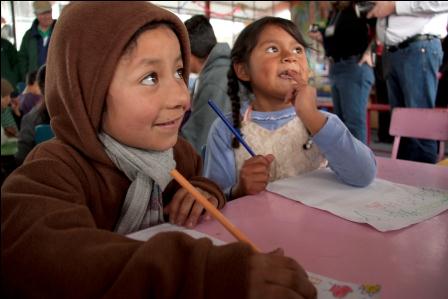
The school day for a child in a developing country is a far cry from what our kids experience here at home.
The advent of a new school year brings with it an uplifting sense of hopefulness, a sentiment that knows no geographic boundaries. For students throughout the world, this new academic term will offer the promise of unbound opportunity, the chance to learn and grow, the possibility to reach beyond their worlds. Like nothing else perhaps, school unlocks the permission to dream.
For students in developing nations, this sense of optimism is no less pervasive. Over the past two years, our global survey of children in some of the world's poorest countries unveiled some common perspectives. When asked what one thing they would do if they were president of their country, the majority of these 10- to 12-year-olds said they would improve schools or build more of them. Polled about their career interests, more than half had their eyes on pursuits that require a college degree, with teacher and doctor accounting for most answers. Hopefulness, without a doubt, is fueled by education.

Credit: ChildFund staff
Watching backpack-laden students return to bus stops recently, I was reminded about these telling attitudes about education and reflected on the stark contrasts between schools in developing counties and those here at home. Visit a school in Ecuador or Zambia or Sri Lanka, and you will be struck by profound differences, some pronounced while others more subtle. Taken together, the sum total of the educational shortcomings among developing countries underscores why students there put schooling atop their list of priorities.
Most conspicuous is the lack of resources. There is a vast shortage of schools in many countries, and despite progress in building more of them, there are still not enough, making overcrowding a common reality. Many school districts divide the school day up into morning and afternoon sessions so as to accommodate more students. Even so, you will frequently find classrooms designed for 30 students brimming with two or three times as many, and desks made for one or two students often have three or more students squeezing around them. There are rarely enough books or classroom supplies. The teachers, whose resourcefulness seems to know no bounds, are masterful at crafting materials out of local products or recycling old supplies to make them go further. Pencils are almost always broken in two so that more than one student will have one. Computers are a seldom-seen luxury. I noticed a computer locked away during one school visit, and when I asked why it was sequestered from the students, I was told that no one was allowed to use it for fear of breaking it.
The lack of adequate classrooms and materials would be an even more acute problem were all of the children who are eligible for school to actually attend. The United Nations estimates that there are some 46 million children in Africa who should be in school but are not. One of the barriers to education has been the fact that many school charged fees, making even a basic education unattainable for many families. While an increasing number of countries have lifted those fees in recent years, unofficial assessments are often levied in order to provide teachers with a living wage. Even the relatively modest cost of school uniforms -- which are mandatory in many schools -- and books can be beyond the reach of many families, another factor in suppressing student enrollment.
The lack of money -- by either the governments or families -- conspire to cause many of the educational challenges within developing nations, but there are also more complicated and nuanced issues as well. Teaching methods, for example, have not kept pace with how we know students learn best. Most teachers instruct in a formal, authoritarian style that puts an emphasis on memorization and discipline, rather than thinking and reasoning. The focus is on instilling the facts needed to pass a standardized test, and repetition and recitation is largely how students learn. I recall one student who apologized to her teacher because she had not provided the answer to an assignment with the exact words that the teacher had used.
Much of ChildFund's work is focused on improving the entire classroom experience. We are not only seeking to improve school conditions but also working on enhancing teaching styles and curricula. Our ATLAS (Active Teaching and Learning Approaches in Schools) program introduces experiential learning, de-emphasizing rote memorization and embracing learning that comes with doing. The program works with teachers to help them develop teaching methods that enable them to assess more, plan better, praise more often and conduct more group and interactive activities. Changes in national curricula can understandably be a sensitive matter, but we also are helping modernize subject matter by integrating new methods and resources into accepted practices.
While progress continues, we still have a long way to go. A generation ago, the adult literacy rate in Africa was just 52 percent; four years ago, two in three African adults could read. Student drop-out rates are way too high, classroom conditions are far from adequate and teaching methods must be enhanced. We know that students value learning, want to stay in school and aspire to continue their education into the highest levels, but the fact is that the hurdles are still too high for most of them to overcome.
Education lays the foundation from which dreams grow, and those dreams are no less ambitious for children in developing countries. But as is often the sad reality within the poorest parts of the world, those whose hopes are the highest will have the most challenging path toward achieving them.
Follow Anne Goddard on Tumblr: www.annegoddard.tumblr.com.